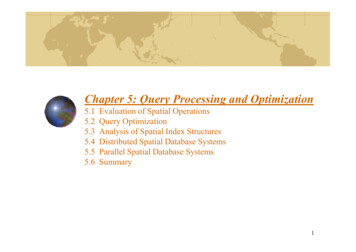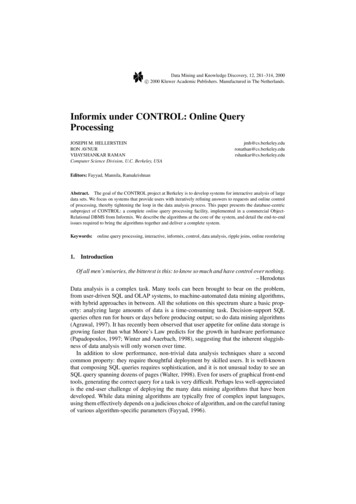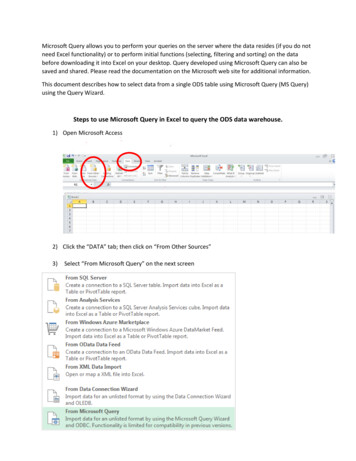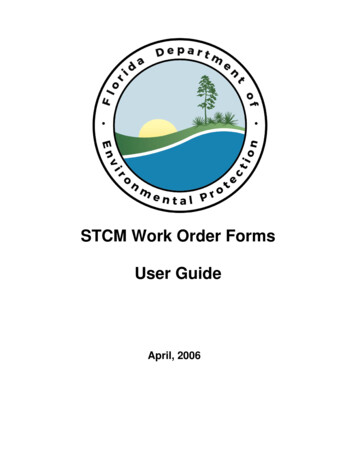
Transcription
Chapter 5: Query Processing and Optimization5.15.25.35.45.55.6Evaluation of Spatial OperationsQuery OptimizationAnalysis of Spatial Index StructuresDistributed Spatial Database SystemsParallel Spatial Database SystemsSummary1
Analogy of Automatic Transmission in CarsManual transmission : automatic :: Java : SQLRecall Java program (Section 2.1.6, pp.32-34)Algorithm to answer the query was coded in the programSimilar to manual gear change at start and stop in CarsIn contrast, SQL queries are declarativeUsers do not specify the procedure to answer itDBMS needs to pick an algorithm to answer queryAnalogy: automatic transmission choosing gear (1, 2, 3, )Relevant SDBMS componentQuery processing and optimization (QPO) picks algorithms to process a SQL queryPhysical data model : QPO :: engine : automatic transmission2
What is Query Processing and Optimization (QPO)?Basic idea of QPOIn SQL, queries are expressed in high level declarative formQPO translates a SQL query to an execution plan over physical data model using operations on file-structures, indices, etc.Ideal execution plan answers Q in as little time as possibleConstraints: QPO overheads are small Computation time for QPO steps that for execution plan3
Why Learn about QPO?Why learn about automatic transmission in a car?Identify cause of lack of power in a car is it the engine or the transmission ?Solve performance problem with manual override uphill, downhill driving lower gearsWhy learn about QPO in a SDBMS?Identify performance bottleneck for a query is it the physical data model or QPO ?How to help QPO speed up processing of a query ? providing hints, rewriting query, etc.How to enhance physical data model to speed up queries? add indices, change file- structures, 4
Three Key Concepts in QPO1. Building blocksMost cars have few motions, e.g. forward, reverseSimilar most DBMS have few building blocks: select (point query, range query), join, sorting, .A SQL query is decomposed in building blocks2. Query processing strategies for building blocksCars have a few gears for forward motion: 1st, 2nd, 3rd, overdriveDBMS keeps a few processing strategies for each building block e.g. a point query can be answer via an index or via scanning data-file3. Query optimizationAutomatic transmission tries to picks best gear given motion parametersFor each building block of a given query, DBMS QPO tries to choose “most efficient” strategy given database parameters parameter examples: table size, available indices, ex. index search is chosen for a point query if the index is available5
QPO ChallengesChoice of building blocksSQL queries are based on relational algebra (RA)Building blocks of RA are select, project, join details in section 3.2 (note symbols sigma, pi and join)SQL3 adds new building blocks like transitive closure will be discussed in chapter 6Choice of processing strategies for building blocksConstraints: Too many strategies higher complexityCommercial DBMS have a total of 10 to 30 strategies 2 to 4 strategies for each building blockHow to choose the best’ strategy from among the applicable ones?May use a fixed priority schemeMay use a simple cost model based on DBMS parameters6
QPO Challenges in SDBMSBuilding Blocks for spatial queriesRich set of spatial data types, operationsA consensus on “building blocks” is lackingCurrent choices include spatial select, spatial join, nearest neighborChoice of strategiesLimited choice for some building blocks, e.g. nearest neighborChoosing best strategiesCost models are more complex since spatial queries are both CPU and I/O intensive while traditional queries are I/O intensiveCost models of spatial strategies are not mature7
QPO Challenges in SDBMS - ExerciseLearning AidOften helpful for readers to try to solve the QPO problemBefore looking at the current solutionsParticularly when solutions are not matureTry following exercise to get an insight into chapter 5 topicsExercise:Propose a few additional building blocks for spatial queries besides spatial selection, spatial join and nearest neighbor use GIS operations (Table 1.1, pp.3) as a guide if neededJustify the proposal by listing spatial queries needing the componentDetail the proposal by listing a few algorithms for the building blockHow would one choose between the available algorithms?8
Scope of DiscussionChapter 5 will discussChoice of building blocks for spatial queriesChoice of processing strategies for building blocksHow to choose the “best” strategy from among the applicable ones?Focus on concepts, not proceduresProcedures change with change in computer hardwareConcepts do not change as oftenReaders are more likely to remember the concepts after the course9
Building Blocks for Spatial QueriesChallenges in choosing building blocksRich set of data types - point, line string, polygon, Rich set of operators - topological, euclidean, set-based, Large collection of computation geometric algorithms for different spatial operations on different spatial data typesDesire to limit complexity of SDBMSHow to simplify choice of data types and operators?Reusing a Geographic Information System (GIS) which already implements spatial data types and operations however may have difficulties processing large data set on diskSDBMS reduces set of objects to be processed by a GISSDBMS is used as a filterThis is filter and refinement approach10
The Filter-Refine ParadigmProcessing a spatial query QFilter step : find a superset S of object in answer to Q using approximate of spatial data type and operatorRefinement step : find exact answer to Q reusing a GIS to process S using exact spatial data type and operationFilter stepRefinement stepQueryLoad object geometryTest on exactgeometrySpatial indexFigure 5.1False hitsCandidate setHitsQuery result11
Approximate Spatial Data TypesApproximating spatial data typesMinimum orthogonal bounding rectangle (MOBR or MBR) approximates line string, polygon, see examples below (black rectangle are MBRs for red objects)MBRs are used by spatial indexes, e.g. R-treeAlgorithms for spatial operations MBRs are simpleQ? Which OGIS operation (Table 3.9, pp.66) returns MBRs ?12
Approximate Spatial OperationsApproximating spatial operationsSDBMS processes MBRs for refinement stepOverlap predicate used to approximate topological operationsExample: inside(A, B) replaced by overlap(MBR(A), MBR(B)) in filter step see picture below - let A be outer polygon and B be the inner one inside(A, B) is true only if overlap(MBR(A), MBR(B)) however overlap is only a filter for inside predicate needingrefinement later13
Filter Step ExampleQuery:List objects in front of a viewer VEquivalent overlap queryDirection region is a polygonList objects overlapping with polygon( front(V))Approximate queryList objects overlapping with MBR(polygon (front (V)))14
Approximate Spatial Operations - 2Exercise: Approximate following using overlap predicateCross(A, B), Touch(A, B), Disjoint(A, B)See Table 3.9, pp.66 for definition of these operations.Exercise: Given MBRs R and S, provide conditions to testOverlap(A, B)Use coordinates of left-lower and upper-right corners of MBRs15
Choice of Building BlocksChoice of building blocksVaries across software vendors and productsRepresentative building blocks are listed hereList of building blocksPoint Query: Name a highlighted city on a digital map return one spatial object out of a tableRange Query: List all countries crossed by the river Amazon returns several objects within a spatial region from a tableSpatial Join: List all pairs of overlapping rivers and countries return pairs from 2 tables satisfying a spatial predicateNearest Neighbor: Find the city closest to Mount Everest return one spatial object from a collection16
Strategies for Each Building BlockChoice of strategiesVaries across software vendors and productsRepresentative strategies are listed hereSome strategies need special file-structures or indicesDescription of strategiesMain message: there are multiple strategies for each building block!Focus on concepts rather than proceduresReaders interested in procedural details (e.g. algorithms) refer to papers in Bibliographic notes note: better algorithms appear in literature every year!17
Strategies for Point QueriesRecall Point Query ExampleName a highlighted city on a digital mapReturn one spatial object out of a tableList of strategiesScan all B disk sectors of the data fileIf records are ordered using space filling curve (say Z-order) then use binary search on the Z-order of search point to examine about log2B disk sectorsIf an index is available on spatial location of data objects, then use find() operation on the index number of disk sector examined index depth (typically 4 to 5)18
Strategies for Range QueriesRecall Range Query ExampleList all countries crossed by of the river AmazonReturns several objects within a spatial region from a tableList of strategiesScan all B disk sectors of the data fileIf records are ordered using space filling curve (say Z-order) then determine range of Z-order values satisfying range queryuse binary search to get lowest Z-order within query answerscan forward in the data file till the highest Z-order satisfying queryIf an index is available on spatial location of data objects, then use range-query operation on the index19
Strategies for Spatial JoinsRecall Spatial Join Example:List all pairs of overlapping rivers and countries.Return pairs from 2 tables satisfying a spatial predicateList of strategiesNested loop: test all possible pairs for spatial predicate all rivers are paired with all countriesSpace Partitioning: test pairs of objects from common spatial regions only rivers in Africa are tested with countries in Africa only!Tree Matching hierarchical pairing of object groups from each tableOther, e.g. spatial-join-index based, external plane-sweep, 20
Strategies for Nearest Neighbor QueriesRecall Nearest Neighbor ExampleFind the city closest to Mount EverestReturn one spatial object from city data file CList of strategiesTwo phase approach fetch C’s disk sector(s) containing the location of Mt. Everest M minimum distance( Mt. Everest, cities in fetched sectors) test all cities within distance M of Mt. Everest (Range Query)Single phase approach recursive algorithm for R-tree eliminate candidates dominated by some other candidate21
Query Processing and Optimizer ProcessA site-seeing tripStart : a SQL QueryEnd: an execution planIntermediate Stopovers query trees logical tree transforms strategy selectionSQL GRAMMERABSTRACT DATA ISTIC URESPECIFICATIONSYSTEM CATALOGDYNAMICPROGRAMMINGWhat happens after the journey?Execution plan is executedQuery answer returnedSelectivity IndexCPUBfrCOST FUNCTIONSPATIALNONSPATIALEVALUATIONMERGEFigure 5.222
Query TreesNodes building blocks of (spatial) queriesSee section 3.2 (pp.55) for symbols sigma, pi and joinChildren inputs to a building blockLeafs TablespExample SQL query and its query tree follows:L.Names Area(L.Geometry) . 20s Fa.Name 5 ‘Campground’Distance(Fa.Geometry, L.Geometry) , 50Figure 5.3Lake LFacilities Fa23
Logical Transformation of Query Trees Motivation Transformation do not change the answer of the query But can reduce computational cost by reducing data produced by sub-queries reducing computation needs of parent node Example Transformation Push down select operation below join Example: Figure 5.4 (compare with Figure 5.3) Reduces size of table for join operations Area(L.Geometry) . 20 Other common transformations Push project down Reorder join operations .p L.NameDistance(Fa.Geometry, L.Geometry) , 50Lake LFigure 5.4s Fa.Name 5 ‘Campground’Facilities Fa24
Logical Transformation and Spatial Queries Traditional logical transform rules For relational queries with simple data types and operations CPU costs are much smaller and I/O costs Need to be reviewed for spatial queries complex data types, operations CPU cost is higher Example:p L.Name Push down spatial selection below join May not decrease cost if area() is costlier than distance()Distance(Fa.Geometry, L.Geometry) , 50sArea(L.Geometry) . 20Figure 5.5Lake Ls Fa.Name 5 ‘Campground’Facilities Fa25
Execution PlansAn execution plan has 3 componentsA query treeA strategy selected for each non-leaf nodeAn ordering of evaluation of non-leaf nodesExampleStrategies for Query tree in Figure 5.5 use scan for Area(L.Geometry) 20 use index for Fa.Name ‘Campground’ use space-partitioning join for Distance(Fa,L) 50 use on-the-fly for projectionOrdering as listed abovesArea(L.Geometry) . 20Lake LFigure 5.5p L.NameDistance(Fa.Geometry, L.Geometry) , 50s Fa.Name 5 ‘Campground’Facilities Fa26
Choosing Strategies for Building BlocksA priority schemeCheck applicability of each strategies given file-structures and indicesChoose highest priority strategyThis procedure is fast, used for complex queriesRule based approachSystem has a set of rules mapping situations to strategy choicesExample: Use scan for range query if result size 10 % of data fileCost based approachSee next slide27
Choosing Strategies for Building Blocks - 2Cost model based approachSingle building block use formulas to estimate cost of each strategy, given table size etc. choose the strategy with least cost example cost models for spatial operation in section 5.3A query tree least cost combination of strategy choices for non-leaf nodes dynamic programming algorithmCommercial practiceRDBMS use cost based approach for relational building blocksBut cost models for spatial strategies are not matureRule based approach is often used for spatial strategies28
Query Decompositionp L.NameNonspatials Fa.Name 5 ‘Campground’Distance(Fa.Geometry, L.Geometry) , 50SpatialLake L.Figure 5.8sArea(L.Geometry) . 20Facilities Fap L.NameNonspatialsArea(L.Geometry) . 20SpatialDistance(Fa.Geometry, L.Geometry) , 50Lake Ls Fa.Name 5 ‘Campground’Facilities FaNonspatial29
Trends in Query Processing and OptimizationMotivationSDBMS and GIS are invaluable to many organizationsPrice of success is to get new requests from customers to support new computing hardware and environment to support new applicationsNew computing environmentsDistributed computing (Section 5.4)Internet and web (Section 5.4)Parallel computers (Section 5.5)New applicationsLocation based services, transportation (Chapter 6)Data Mining (Chapter 7)Raster data (Chapter 8)30
Distributed Spatial DatabasesDistributed EnvironmentsCollection of autonomous heterogeneous computersConnected by networksClient-server architectures server computer provides well-defined services client computers use the servicesNew issues for SDBMSConceptual data model translation between heterogeneous schemasLogical data model naming and querying tables in other SDBMSs keeping copies of tables (in other SDBMs) consistent with original tableQuery Processing and Optimization cost of data transfer over network may dominate CPU and I/O costs new strategies to control data transfer costs31
Distributed SDBMS - 2 Data-transfer strategies for joining 2 table at different sites Transfer one table to the other site Semi-join strategy transfer join column of one table to the other site transfer back the matching rows of the other table back to first site Semi-join often is cheaper than transferring a table to other site detailed Example in section 5.4.2 (pp.135)FARMFigure 5.9: Two tables atdifferent sites to be joinedon overlap of D MBRoverlap FARM MBRFID(10 bytes)OWNER NAME(10 bytes)FARM BOUNDARY(2000 bytes)FARM MBR(16 bytes)DISEASE NAME(20 bytes)DISEASE BOUNDARY(2000 bytes)D MBR(16 bytes)DISEASE MAPMAP-ID(10 bytes)32
Internet and (World-wide-) webInternet and Web EnvironmentsVery popular medium of information access in last few yearsA distributed environmentWeb servers, web clients common data formats (e.g. HTML, XML) common communication protocols (e.g. http) naming - uniform resource locator (url), e.g. www.cs.umn.eduNew issues for SDBMSOffer SDBMS service on webUse Web data formats, communication protocols etc. example on next slideEvaluate and improve web for SDBMS clients and servers33
Web-based Spatial Database Systems SDBMS on web MapServer case study SDBMS talks to a web server web server talks to web clientsFigure 5.10PInternetWeb ClientsQuery EngineWGIS(MapServer)WMS(OGC)CGIWeb ServerCommunication Layer Several web based products Web data formats for spatial data GML WMSHTT Commercial practiceHTTPHTTPClients (Std. Browsers)Static Images (GIF)GMLView (GML)Geospatial Analysis LayerServer Side Client SideComponents ComponentsGeospatial Database Access LayerSpatialDatabaseRDBMS34
Parallel Spatial DatabasesParallel EnvironmentsComputer with multiple CPUs, Disk drives (Figure 5.11 for examples)All CPUs and disk available to a SDBMSCan speed-up processing of spatial queries!Interconnection NetworkPPPPPPInterconnection NetworkMMMGlobal Shared MemoryDDDSHARED-NOTHING(a)Figure 5.11DDDSHARED-MEMORY(b)MMMPPPInterconnection NetworkDDDSHARED-DISK(c)35
Parallel Spatial Databases - 2New issues for DBMSPhysical Data Model declustering: how to partition tables, indices across disk drives?Query Processing and Optimization query partitioning: how to divide queries among CPUs? cost model of strategies on parallel computersExample: Techniques for declustering (Figure 5.12)Simple technique: round robin based on an order (space filling curve)Disk36
Declustering for Data Partitioning Example A Simple Techniques for declustering (Figure 5.12)1. Order the spatial objects using a space filling curve2. Allocate to disk drives in a round robin manner Effective for point objects, e.g. pixels in an image Many queries, e.g. large MBRs are parallelized well Example: consider a query to retrieve data in bottom-left quarterof the space two data points retrieved from each disk drive for 147251472503625036147Linear Methoddisk-id 5(x 1 5y) mod 4321076CMD Methoddisk-id 5(x 1 y) mod 86543210742 43 46 47 58 59 62 6340 41 44 45 56 57 60 6134 35 38 39 50 51 54 5532 33 36 37 48 49 52 5310 11 14 15 26 27 30 318 9 12 13 24 25 28 292 3 6 7 18 19 22 230 1 4 5 16 17 20 6464646475757575Z-Curve Method - disk-id 5 Z(x, y) mod 863 62 49 48 47 44 43 4260 61 50 51 46 45 40 4159 56 55 52 33 34 39 3858 57 54 53 32 35 36 375 6 9 10 31 28 27 264 7 8 11 30 29 24 253 2 13 12 17 18 23 220 1 14 15 16 19 20 30613074Hilbert Method - disk-id 5 H(x, y) mod 83721522165
A Case Study: High Performance GISGoal: Meet the response timeconstraint for real time battlefieldterrain visualization in flight simulator.Methodology:Data-partitioning approachEvaluation on parallel computers,e.g. Cray T3D, SGI Challenge.Significance: A major improvement incapability of geographic informationsystems for determining the subset ofterrain polygons within the view pointDividing a Map among 4(Range Query) of a soldier in a flightprocessors. Polygons within asimulator using real geographicprocessor have common38colorterrain data set.
A Case Study: High Performance GIS(1/30) second Response time constraint on Range QueryParallel processing necessary since best sequential computercannot meet requirementGreen rectangle a range query, Polygon colors shows processorassignmentGraphicsEngineDisplay30 Hz. ViewGraphicsSet ofPolygons2Hz.8Km X 8KmBounding BoxLocalTerrainDatabaseSet ofPolygons25 Km X 25 KmBounding BoxHigh PerformanceGIS ComponentRemoteTerrainDatabasesDividing a Map among 4 processors. Polygonswithin a processor have common color39
Real Time Visualization: A Case Study2/sec, 8km 3 8kmRange queryDisplay30/secGraphicsanalysisengineSet ofPolygonsViewFeedbackSecondary terraindatabasedatabaseSet ofPolygonsSDBMSFigure 5.13Options for Dividing Bounding BoxOptions for Dividing the Polygon DataNo DivisionSubsetsof polygonsSubsets ofsmall polygonsSubsetsof edgesNoDivisionIIIIIIIVDivideintosmall boxesIIIIIIIIIIVDivideintoedgesIVIVIVIVFigure 5.16Approx. f the resultDLBSYNCGetnextBboxApprox. filteringcomputationFigure 5.14 Range nPolygonizationof the resultDLBFigure 5.1540
SummaryQuery processing and optimization (QPO)translates SQL Queries to execution planQPO process steps includeCreation of a query tree for the SQL queryChoice of strategies to process each node in query treeOrdering the nodes for executionKey ideas for SDBMS includeFilter-Refine paradigm to reduce complexityNew building blocks and strategies for spatial queries41
3. Query optimization Automatic transmission tries to picks best gear given motion parameters For each building block of a given query, DBMS QPO tries to choose "most efficient" strategy given database parameters parameter examples: table size, available indices, ex. index search is chosen for a point query if the index is .











